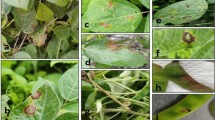Abstract
A mycological survey was carried out on rice samples harvested in 1997 and 1998 from Entre Ríos province, belonging to the main production area of Argentina. The relative density and isolation frequency of the prevalent fungi were statistically compared between locations and harvest seasons. The genusAlternaria was the most prevalent component of the internal seedborne mycoflora in the two harvest seasons. Fungi belonging to the generaPhoma, Fusarium, Microdochium, Penicillium andAspergillus were also isolated. The predominant species of these genera wereAlternaria alternata, Phoma glomerata, Fusarium graminearum, Microdochium nivale, Penicillium citrinum and Aspergillus flavus.
Similar content being viewed by others
References
Broggi LE (1998) Study of the contaminant mycoflora distribution in freshly harvested rice grain at Entre Ríos province, Argentina. Mycotoxins natural occurrence risk in the Argentinian rice producing area. Buenos Aires University Magister Thesis
Tonón SA, Marucci RS, JerkeG, García (1997) Mycoflora of paddy and milled rice produced in the region of north eastern Argentina and southern Paraguay. International Journal of Food Microbiology 37: 231 - 235
González HHL, Resnik SL, BocaR, Marasas WFO(1995) Mycoflora of Argentinian corn harvested in the main production area in 1990. Mycopathologia 130:29–36
Nelson PE, Toussoun TA, Marasas WFO (1983)Fusarium species: an illustrated manual for identification.The Pennsylvania State University Press,University Park, Pennsylvania
Pitt JI, Hocking AD (1997) Fungi and Food Spoilage. Blackie Academic & Professional, London-New York
Hollier CA, Groth DE, Rush MC, Webster RK (1998) Common Names of Plant Diseases. N° 59. Rice (Oryza sativa L.). The American Phytopathological Society, APSnet (http://www.scisoc.org/resource/common/names/rice.htm)
Megalla S, Bennett G, Ellis JJ, Shotwell OL (1987) Production of deoxynivalenol and zearalenone by isolates ofFusarium graminearum Schw. Journal of Food Protection 50: 826 - 828
Moltó GA, Samar MM, Resnik SL, Martínez EJ, Pacin AM (2000) Occurrence of thrichothecenes in Argentinian beer: a preliminary exposure assessment. Food Additives and Contaminants 17: 809 - 813
Conover WJ (1980) Practical Nonparametric Statistic. John Wiley & Sons, New York.
Statistix. Version 4.1 (1994) User’s Manual. Analytical Software. Borland International Inc. and Fleming Software
Kuthubutheen AJ (1979) Thermophilic fungi associated with freshly harvested rice seeds. Transactions of the British Mycological Society 73: 357 - 359
Mallick AK, NandiB (1981) Research: rice-Results of Indian experiments. Rice Journal 84: 19 - 23
Pitt JI, Hocking AD, BhudhasamaiK, Miscamble BF, Wheeler KA, Tanboon-EkP (1994) The normal mycoflora of commodities from Thailand. 2. Beans, rice, small grains and other commodities. International Journal of Food Microbiology 23:35–53
Abdel-Hafez SII, El-Kady IA, Mazen MB, El-Maghraby AD (1987) Mycoflora and trichothecene toxins of paddy grain from Egypt.Mycopathologia 100: 103–112
LaceyJ, MaganN(1991) Fungi in cereal grains: their occurrence and water and temperature relations. In: Chelkowsky J (ed.), Cereal Grain. Mycotoxins, Fungi and Quality in Drying and Storage, Elsevier, Amsterdam pp. 77–177
Waller JM, BraydfordD (1990)Fusarium diseases in the tropics. TPM Special Review N° 3, Tropical Pest Management 36: 181–194
Diamond H, Cooke BM, DunneB (1995) Axil blotch of Oats — A new foliar disease caused byMicrodochium nivale var.nivale. Proceedings of the International Seminar onFusarium. Mycotoxins, Taxonomy and Pathogenicity. Martina Franca, Italy, pp. 82
Marasas WFO(1992) Toxigenic Fusaria. In: Smith JC & Henderson RS (eds.), Animal Food, CRC Press Inc., Boca Raton, pp. 119–139
IchinoeM, KurataH, SugiuraH, UenoY (1983) Chemotaxonomy ofGibberella zeae with special reference to production of trichothecenes and zearalenone. Applied of Environmental Microbiology 46: 1364–1369
Miller JD, Greenhalgh R, WangY, LuM (1991) Trichothecenes chemotypes of threeFusarium species. Mycologia 83: 121–130
Miller JD, Taylor A, Greenhalgh R (1983) Production of deoxynivalenol and related compounds in liquid culture byFusarium graminearum. Canadian Jounal of Microbiology 29: 1171–1178
SzécsiA, BartokT (1995) Trichothecene chemotypes ofFusarium graminearum isolated from corn in Hungary. Proceedings of the International Seminar onFusarium. Mycotoxins, Taxonomy and Pathogenicity. Martina Franca, Italy, p. 59
Marasas WFO, Nelson PE, Toussoun TA (1984) ToxigenicFusarium species. Identity and micotoxicology. The Pennsylvania State University Press, University Park, pp. 5–11 and 155-211
MoltóG, González HHL, Resnik SL, Pereyra González A (1997) Production of trichothecenes and zearalenone by isolates ofFusarium spp. from Argentinian maize. Food Additives and Contaminants 14: 263–268
LangsethW, BernhoftA, RundbergetT, KosiakB; GareisM (1998) Mycotoxin production and cytotoxicity ofFusarium strains isolated from Norwegian cereals. Mycopathologia 144: 103–113
Author information
Authors and Affiliations
Rights and permissions
About this article
Cite this article
LE, B., Moltó, G. Fungi associated with rice at entre rios province, Argentina. toxigenic capacity offusarium graminearum andmicrodochium nivale isolates. Mycotox Res 17, 96–107 (2001). https://doi.org/10.1007/BF02946132
Received:
Accepted:
Issue Date:
DOI: https://doi.org/10.1007/BF02946132




